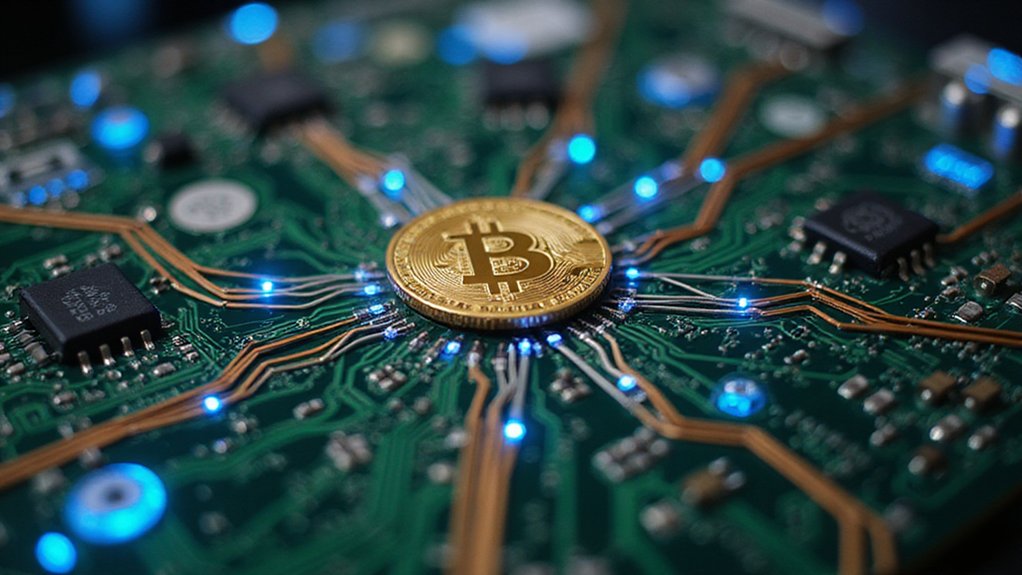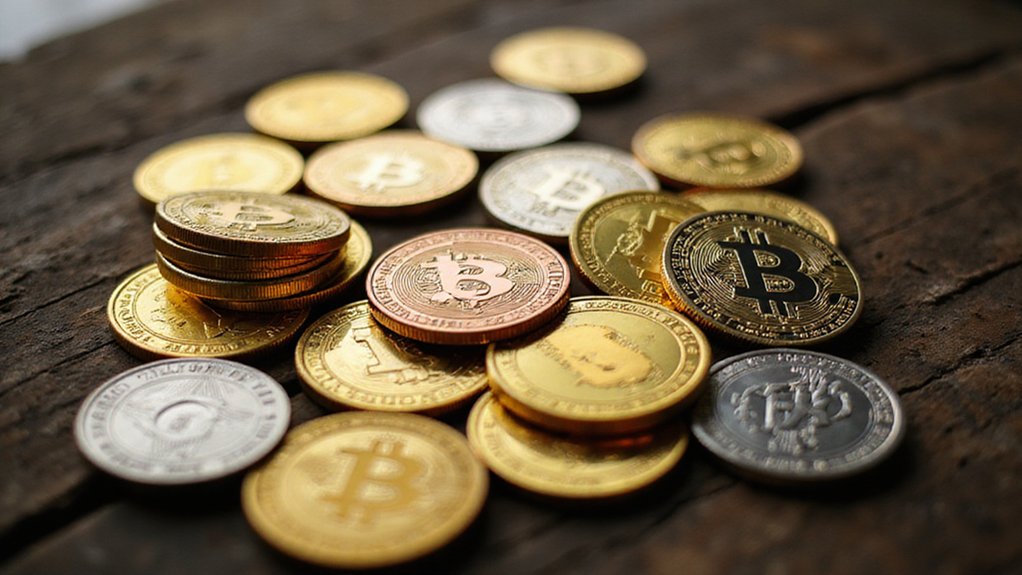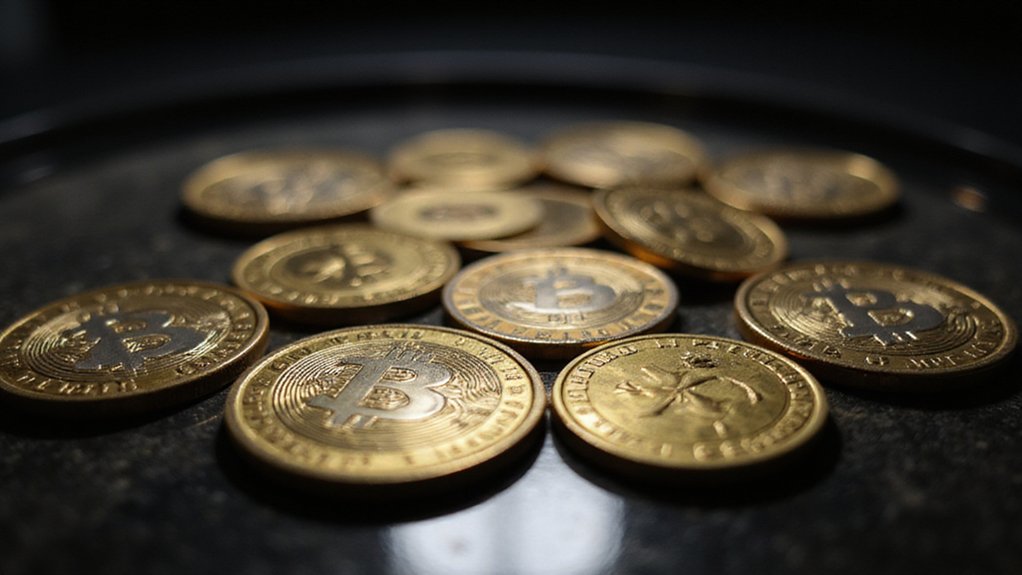An automated market maker (AMM) eliminates the quaint notion of finding trading counterparts by using mathematical formulas—typically the constant product equation x*y=k—to price cryptocurrency swaps through liquidity pools. These algorithmic systems rely on users depositing paired tokens into smart contracts, earning trading fees while risking impermanent loss when token prices diverge. Major platforms like Uniswap process trillions annually, democratizing market-making functions once reserved for institutional specialists, though the mathematical precision beneath reveals fascinating complexities.

The traditional stock exchange, with its frenzied trading floors and synchronized order matching, seems quaint compared to the elegant brutality of automated market makers—algorithmic entities that have quietly revolutionized cryptocurrency trading by eliminating the need for buyers and sellers to find each other entirely.
These AMMs operate through liquidity pools containing paired tokens, where mathematical formulas (typically the constant product equation x*y=k) determine prices rather than human negotiation.
Users deposit equal values of two tokens into these pools, becoming liquidity providers who earn trading fees while shouldering the peculiar risk of “impermanent loss”—a phenomenon where providing liquidity becomes less profitable than simply holding the tokens.¹
Smart contracts execute swaps automatically based on pool reserves, updating prices in real-time as trades shift token balances.
This mechanism guarantees continuous liquidity; pools theoretically cannot empty completely, though slippage increases dramatically as reserves dwindle.
The system operates 24/7 without intermediaries, KYC requirements, or centralized approval—a libertarian’s fever dream made manifest through code.
Major platforms like Uniswap, SushiSwap, and PancakeSwap process trillions in annual volume, enabling trading for obscure tokens that traditional exchanges would dismiss.
Anyone can create new trading pairs or provide liquidity, democratizing market-making functions previously reserved for institutional specialists.
The security model relies entirely on blockchain immutability and transparent smart contracts, eliminating single points of failure while introducing new vulnerabilities (smart contract bugs, anyone?).
This decentralized architecture proves remarkably resilient to manipulation attempts that plague centralized exchanges. Arbitrage opportunities naturally emerge when price differences develop between different AMMs and centralized exchanges, allowing traders to profit while helping maintain price consistency across platforms. AMMs potentially deliver lower fees compared to traditional centralized exchanges, making them particularly attractive for frequent traders.
Liquidity providers face a curious trade-off: they earn fees from every swap but risk impermanent loss when token prices diverge substantially from their initial ratio. Beyond traditional fee earnings, many platforms now incentivize participation through liquidity mining programs that reward providers with additional cryptocurrency tokens for their contributions.
The mathematics are unforgiving—providers might earn 0.3% fees while losing 5% to impermanent loss, a harsh lesson in DeFi’s risk-reward dynamics.
AMMs represent foundational infrastructure for decentralized finance, transforming trading from a social activity requiring counterparty matching into a purely mathematical exercise.
Their success demonstrates how algorithmic precision can replace human inefficiency, though whether this constitutes progress or merely sophisticated automation remains philosophically debatable.
¹The term “impermanent” suggests temporary inconvenience when the loss often proves quite permanent indeed.
Frequently Asked Questions
What Are the Main Risks of Providing Liquidity to AMMS?
Liquidity providers face three primary risks when depositing assets into AMM pools.
Impermanent loss—perhaps the most ironically named concept in DeFi—occurs when asset price ratios diverge, creating opportunity costs compared to simply holding tokens.
Slippage affects execution prices during volatile periods, while shallow pool depth exacerbates these effects.
Market manipulation remains surprisingly feasible given blockchain transparency, allowing sophisticated actors to exploit predictable algorithmic pricing mechanisms.
How Do AMM Fees Get Distributed to Liquidity Providers?
AMM fees flow to liquidity providers through an elegantly simple proportional distribution system—though one might wonder why such straightforward math required revolutionary blockchain technology.
Trading fees accumulate in pools, then distribute automatically based on each provider’s stake percentage.
A provider holding 2% of pool liquidity receives exactly 2% of collected fees, with platforms like CoinEx depositing earnings directly into accounts without manual intervention required.
Which Cryptocurrencies Work Best With Automated Market Makers?
Stablecoins and high-liquidity tokens perform exceptionally well in AMMs, offering minimal slippage and consistent trading volumes.
Ethereum-based tokens naturally dominate given most AMMs operate on Ethereum, while major cryptocurrencies like ETH and wrapped Bitcoin provide robust liquidity pools.
Surprisingly, even obscure DeFi tokens can thrive—assuming sufficient liquidity exists to prevent devastating impermanent loss.
The key lies in trading volume and pool depth rather than token prestige.
Can AMMS Be Hacked or Exploited by Malicious Actors?
AMMs face considerable exploitation risks, from smart contract vulnerabilities to sophisticated liquidity pool manipulation.
Malicious actors employ price manipulation tactics, front-running attacks, and arbitrage exploits—with some protocols losing millions through flash loan attacks and reentrancy exploits.
While regular audits and diversified liquidity pools provide protection, the immutable nature of smart contracts means vulnerabilities, once deployed, become permanent attack vectors until governance mechanisms can implement fixes.
What’s the Difference Between AMMS and Traditional Cryptocurrency Exchanges?
AMMs fundamentally diverge from traditional cryptocurrency exchanges through their algorithmic pricing mechanisms versus order book matching.
While Coinbase requires counterparty discovery, Uniswap’s constant product formula enables instant execution against liquidity pools.
Traditional exchanges demand KYC compliance and professional market makers, whereas AMMs democratize liquidity provision—anyone can deposit token pairs and earn fees.
The trade-off? AMMs offer permissionless access and transparency but introduce impermanent loss risks absent in conventional trading platforms.









